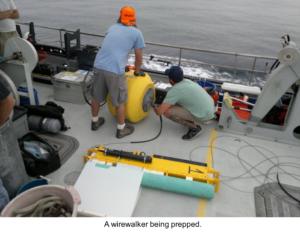This project was a large collaborative project that included researchers from USC, Moss Landing Marine Laboratory, Monterey Bay Aquarium Research Institute, the Southern California Coastal Water Research Project, HAB Monitoring & Reference Branch of the National Centers for Coastal Ocean Science, the University of California Los Angeles and the University of California Santa Cruz. It was funded through the Ecology of Harmful Algal Blooms (EcoHAB) program of NOAA, and involved the application of multiple cutting-edge in-situ observational technologies, extensive shipboard sampling and laboratory analyses to study and understand two ‘hot spots’ of harmful algal blooms along the U.S. west coast. The San Pedro Shelf within the Southern California Bight, and Monterey Bay in central California have experienced annually-recurring blooms of toxic algae. The primary objective of this project was a comparison of these two ecosystems with the intent of revealing commonalities that might explain why they are prone to these harmful events.

The technologies employed included several autonomous underwater vehicles and devices, and provided an unprecedented amount of information on the chemistry, physics and biology of the water column in these regions. One of the application areas for this project involved work with the Orange County Sanitation District. During 2012 the District conducted a 3-week diversion of their effluent discharge into nearshore waters off Newport Beach, CA. The discharge constituted a considerable injection of secondarily-treated effluent into the coastal ecosystem, and therefore a potential stimulatory event for algal blooms in the region. Our group deployed numerous instruments in the vicinity of the discharge, and undertook multiple shipboard sampling efforts to monitor the response of the plankton community to the nutrient injection over the duration of the diversion.



 Another comparison made possible by this project was interannual variability in plankton toxin concentrations at each of the study sites (as well as between study sites). For example, field studies conducted on the San Pedro Shelf during 2013 and 2014 indicated that, although peak abundances of Pseudo-nitzschia did not differ between years, concentrations of domoic acid in the plankton varied by two orders of magnitude. This observation points to the importance of particular species within the diatom genus Pseudo-nitzschia as a major factor controlling toxin concentrations in the plankton.
Another comparison made possible by this project was interannual variability in plankton toxin concentrations at each of the study sites (as well as between study sites). For example, field studies conducted on the San Pedro Shelf during 2013 and 2014 indicated that, although peak abundances of Pseudo-nitzschia did not differ between years, concentrations of domoic acid in the plankton varied by two orders of magnitude. This observation points to the importance of particular species within the diatom genus Pseudo-nitzschia as a major factor controlling toxin concentrations in the plankton.